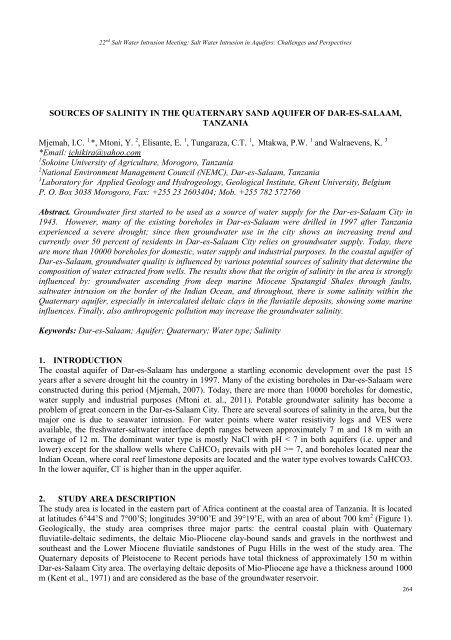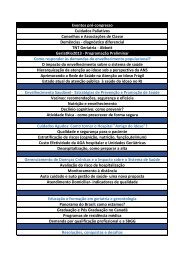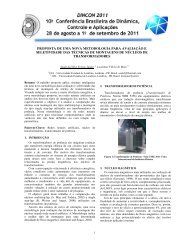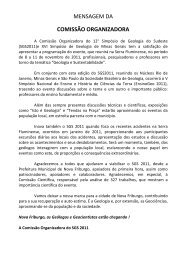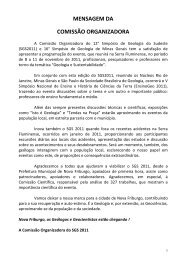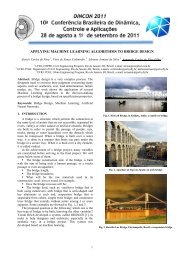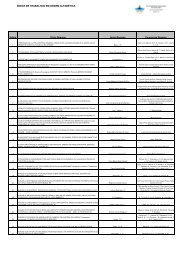Here - Meta Marketing e Eventos
Here - Meta Marketing e Eventos
Here - Meta Marketing e Eventos
- No tags were found...
You also want an ePaper? Increase the reach of your titles
YUMPU automatically turns print PDFs into web optimized ePapers that Google loves.
22 nd Salt Water Intrusion Meeting: Salt Water Intrusion in Aquifers: Challenges and PerspectivesSOURCES OF SALINITY IN THE QUATERNARY SAND AQUIFER OF DAR-ES-SALAAM,TANZANIAMjemah, I.C. 1 *, Mtoni, Y. 2 , Elisante, E. 1 , Tungaraza, C.T. 1 , Mtakwa, P.W. 1 and Walraevens, K. 3*Email: ichikira@yahoo.com1 Sokoine University of Agriculture, Morogoro, Tanzania2 National Environment Management Council (NEMC), Dar-es-Salaam, Tanzania3 Laboratory for Applied Geology and Hydrogeology, Geological Institute, Ghent University, BelgiumP. O. Box 3038 Morogoro, Fax: +255 23 2603404; Mob. +255 782 572760Abstract. Groundwater first started to be used as a source of water supply for the Dar-es-Salaam City in1943. However, many of the existing boreholes in Dar-es-Salaam were drilled in 1997 after Tanzaniaexperienced a severe drought; since then groundwater use in the city shows an increasing trend andcurrently over 50 percent of residents in Dar-es-Salaam City relies on groundwater supply. Today, thereare more than 10000 boreholes for domestic, water supply and industrial purposes. In the coastal aquifer ofDar-es-Salaam, groundwater quality is influenced by various potential sources of salinity that determine thecomposition of water extracted from wells. The results show that the origin of salinity in the area is stronglyinfluenced by: groundwater ascending from deep marine Miocene Spatangid Shales through faults,saltwater intrusion on the border of the Indian Ocean, and throughout, there is some salinity within theQuaternary aquifer, especially in intercalated deltaic clays in the fluviatile deposits, showing some marineinfluences. Finally, also anthropogenic pollution may increase the groundwater salinity.Keywords: Dar-es-Salaam; Aquifer; Quaternary; Water type; Salinity1. INTRODUCTIONThe coastal aquifer of Dar-es-Salaam has undergone a startling economic development over the past 15years after a severe drought hit the country in 1997. Many of the existing boreholes in Dar-es-Salaam wereconstructed during this period (Mjemah, 2007). Today, there are more than 10000 boreholes for domestic,water supply and industrial purposes (Mtoni et. al., 2011). Potable groundwater salinity has become aproblem of great concern in the Dar-es-Salaam City. There are several sources of salinity in the area, but themajor one is due to seawater intrusion. For water points where water resistivity logs and VES wereavailable, the freshwater-saltwater interface depth ranges between approximately 7 m and 18 m with anaverage of 12 m. The dominant water type is mostly NaCl with pH < 7 in both aquifers (i.e. upper andlower) except for the shallow wells where CaHCO 3 prevails with pH >= 7, and boreholes located near theIndian Ocean, where coral reef limestone deposits are located and the water type evolves towards CaHCO3.In the lower aquifer, Cl - is higher than in the upper aquifer.2. STUDY AREA DESCRIPTIONThe study area is located in the eastern part of Africa continent at the coastal area of Tanzania. It is locatedat latitudes 6°44’S and 7°00’S; longitudes 39°00’E and 39°19’E, with an area of about 700 km 2 (Figure 1).Geologically, the study area comprises three major parts: the central coastal plain with Quaternaryfluviatile-deltaic sediments, the deltaic Mio-Pliocene clay-bound sands and gravels in the northwest andsoutheast and the Lower Miocene fluviatile sandstones of Pugu Hills in the west of the study area. TheQuaternary deposits of Pleistocene to Recent periods have total thickness of approximately 150 m withinDar-es-Salaam City area. The overlaying deltaic deposits of Mio-Pliocene age have a thickness around 1000m (Kent et al., 1971) and are considered as the base of the groundwater reservoir.264


